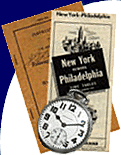

| home | articles | briefs | classifieds | flimsies | interchange |
 |
 |
||||||
|
|||||||
 |
RyPN Briefs December 1, 2006 previous brief ~ return to briefs index ~ next brief Book Review: "Cooperation Moves the Public: Shore Line Interurban Historical Society Dispatch Number 1" by Bruce G. Moffat Next year marks the 50th anniversary of the end of regular service on the Chicago, Aurora, and Elgin Railroad. The line, known as "The Great Third Rail," and "The Roarin' Elgin" was known for intensive scheduling of regular interurban trains in and out of Chicago. Like its sister road, the Chicago, North Shore, and Milwaukee, the C.A.& E. operated over the tracks of Chicago's L into and out of the Loop central business district. Now, the Shore Line Interurban Historical Society, through noted Chicago electric rail author Bruce Moffat, covers in detail the operations of the interurban line from downtown Chicago to Deplaines Avenue, from the period of 1905 until expressway construction forced the curtailment of direct C.A.& E. service to downtown Chicago in September 1953. Chicago-bound commuters then had to transfer from their interurbans to CTA trains for a slow ride into downtown over temporary track laid on top of the street. Facing declining ridership after the loss of the one-seat ride into downtown Chicago, coupled with improvements in the competing C&NW commuter service, the Roarin' Elgin abandoned service in the middle of the day on July 3, 1957, stranding thousands of commuters in downtown Chicago with no ride home. The book also covers the operations of Aurora, Elgin, and Chicago (later the C.A.& E.) over the tracks of the Met-L into downtown Chicago and the Wells Street Terminal. In an era before cab signals, two-way radio, when the L had no wayside signals, and when trains were dispatched by timetable, it was not uncommon for trains to have headways of seconds, not minutes, on the route, where motormen and train crews were expected to closely follow trains based on sight. It was an era of iron men operating wooden and steel trains safely. Keeping regular L traffic, as well as local and limited service of the C.A.& E moving on this line was a challenging proposal for the operating departments of both companies. CRT Rule 158 simply stated "NO COLLISION WITH ANOTHER TRAIN WILL BE EXCUSED." Bruce Moffat, known for his two previous book-length publications, CERA bulletins on the formative years of the Chicago L system, and of the underground Chicago Tunnel Company railroad company, conducted extensive research for this book. Besides the excellent photographs and text that one expects from both Moffat and Shoreline, the book contains two fold-out string charts, which clearly demonstrate the veritable railroad ballet that went on to keep traffic moving safely on the Garfield Park Branch. The softbound book, 82 pages in length, is well laid-out and contains many good photos. The concept of the book, a Dispatch, was to allow Shore Line to publish in-depth features on a variety of subjects on an ad-hoc basis. Best known for their quarterly publication, "First and Fastest," this work mirrors the high quality publication that one expects these days from the people at Shore Line. This book is an excellent addition for anyone interested in electric railroads, interubans, Chicago rail history, or rapid transit. It can be purchased for $24.95 plus $3.00 shipping and handling. Shore Line members receive a discount. The order form is available here. |
|
Copyright © 1998 thru 2025, all rights reserved, contents may not be used without permission. |